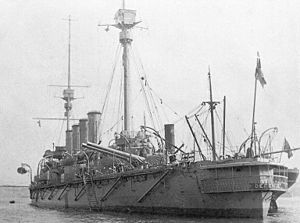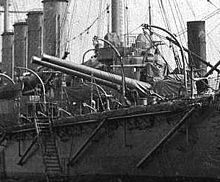
HMS Queen Mary was the last battlecruiser built by the Royal Navy before the First World War. The sole member of her class, Queen Mary shared many features with the Lion-class battlecruisers, including her eight 13.5-inch (343 mm) guns. She was completed in 1913 and participated in the Battle of Heligoland Bight as part of the Grand Fleet in 1914. Like most of the modern British battlecruisers, the ship never left the North Sea during the war. As part of the 1st Battlecruiser Squadron, Queen Mary attempted to intercept a German force that bombarded the North Sea coast of England in December 1914, but was unsuccessful. The ship was refitting in early 1915 and missed the Battle of Dogger Bank in January, but participated in the largest fleet action of the war, the Battle of Jutland in mid-1916. She was hit twice by the German battlecruiser Derfflinger during the early part of the battle and her magazines exploded shortly afterwards, sinking the ship.
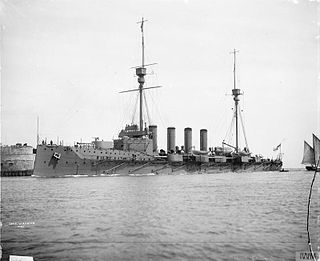
HMS Warrior was a Warrior-class armoured cruiser built for the Royal Navy in the first decade of the 20th century. She was stationed in the Mediterranean when the First World War began and participated in the pursuit of the German battlecruiser SMS Goeben and light cruiser SMS Breslau. Warrior was transferred to the Grand Fleet in December 1914 and remained there for the rest of her career. She was heavily damaged during the Battle of Jutland in 1916, after which she withdrew and was later abandoned and sank in a rising sea.

HMS Inflexible was one of three Invincible-class battlecruisers built for the Royal Navy before World War I and had an active career during the war. She tried to hunt down the German battlecruiser SMS Goeben and the light cruiser SMS Breslau in the Mediterranean Sea when war broke out and she and her sister ship Invincible sank the German armoured cruisers SMS Scharnhorst and SMS Gneisenau during the Battle of the Falkland Islands. Inflexible bombarded Turkish forts in the Dardanelles in 1915, but was damaged by return fire and struck a mine while maneuvering. She had to be beached to prevent her from sinking, but she was patched up and sent to Malta, and then Gibraltar for more permanent repairs. Transferred to the Grand Fleet afterwards, she damaged the German battlecruiser Lützow during the Battle of Jutland in 1916 and watched Invincible explode. She was deemed obsolete after the war and was sold for scrap in 1921.

HMS Duke of Edinburgh was the lead ship of the Duke of Edinburgh-class armoured cruisers built for the Royal Navy in the early 1900s. She was stationed in the Mediterranean when the First World War began and participated in the pursuit of the German battlecruiser SMS Goeben and light cruiser SMS Breslau. After the German ships reached Ottoman waters, the ship was sent to the Red Sea in mid-August to protect troop convoys arriving from India. Duke of Edinburgh was transferred to the Grand Fleet in December 1914 and participated in the Battle of Jutland in May 1916. She was not damaged during the battle and was the only ship of her squadron to survive. She was eventually transferred to the Atlantic Ocean in August 1917 for convoy escort duties.

HMS Indomitable was one of three Invincible-class battlecruisers built for the Royal Navy before World War I and had an active career during the war. She tried to hunt down the German ships Goeben and Breslau in the Mediterranean when war broke out and bombarded Turkish fortifications protecting the Dardanelles even before the British declared war on Turkey. She helped to sink the German armoured cruiser Blücher during the Battle of Dogger Bank in 1915 and towed the damaged British battlecruiser HMS Lion to safety after the battle. She damaged the German battlecruisers Seydlitz and Derfflinger during the Battle of Jutland in mid-1916 and watched her sister ship HMS Invincible explode. Deemed obsolete after the war, she was sold for scrap in 1921.

HMS Colossus was the lead ship of her class of two dreadnought battleships built for the Royal Navy at the end of the first decade of the 20th century. She spent her whole career assigned to the Home and Grand Fleets, often serving as a flagship. Aside from participating in the Battle of Jutland in May 1916 and the inconclusive action of 19 August, her service during World War I generally consisted of routine patrols and training in the North Sea. Colossus was the only dreadnought from the main body of the Grand Fleet to be hit during the Battle of Jutland, although she suffered only minor damage. The ship was deemed obsolete after the war and was reduced to reserve and then became a training ship. Colossus was hulked in 1923 and sold for scrap in 1928.

The Renown class consisted of two battlecruisers built during the First World War for the Royal Navy. They were originally laid down as improved versions of the Revenge-class battleships, but their construction was suspended on the outbreak of war on the grounds they would not be ready in a timely manner. Admiral Lord Fisher, upon becoming First Sea Lord, gained approval to restart their construction as battlecruisers that could be built and enter service quickly. The Director of Naval Construction (DNC), Eustace Tennyson-D'Eyncourt, quickly produced an entirely new design to meet Admiral Lord Fisher's requirements and the builders agreed to deliver the ships in 15 months. They did not quite meet that ambitious goal, but they were delivered a few months after the Battle of Jutland in 1916. They were the world's fastest capital ships upon their commissioning.

HMS Benbow was the third of four Iron Duke-class battleships of the Royal Navy, the third ship to be named in honour of Admiral John Benbow. Ordered in the 1911 building programme, the ship was laid down at the William Beardmore and Company shipyard in May 1912, was launched in November 1913, and was completed in October 1914, shortly after the outbreak of the First World War. The four Iron Dukes were very similar to the preceding King George V class, with an improved secondary battery. She was armed with a main battery of ten 13.5-inch (343 mm) guns and twelve 6 in (152 mm) secondary guns. The ship was capable of a top speed of 21.25 knots, and had a 12-inch (305 mm) thick armoured belt.
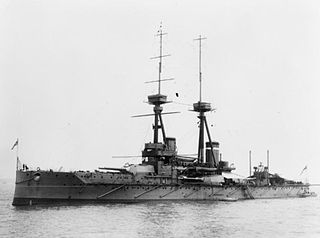
HMS Collingwood was a St Vincent-class dreadnought battleship built for the Royal Navy in the first decade of the 20th century. She spent her whole career assigned to the Home and Grand Fleets and often served as a flagship. Prince Albert spent several years aboard the ship before and during World War I. At the Battle of Jutland in May 1916, Collingwood was in the middle of the battleline and lightly damaged a German battlecruiser. Other than that battle, and the inconclusive action of 19 August, her service during the war generally consisted of routine patrols and training in the North Sea. The ship was deemed obsolete after the war; she was reduced to reserve and used as a training ship before being sold for scrap in 1922.
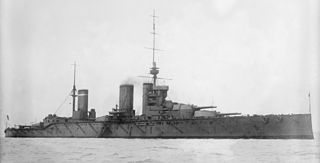
The Lion class were a pair of battlecruisers built for the Royal Navy before World War I. Nicknamed the "Splendid Cats", the ships were a significant improvement over their predecessors of the Indefatigable class in speed, armament and armour. These improvements were in response to the German battlecruisers of the Moltke class, which were in turn larger and more powerful than the first British battlecruisers of the Invincible class.

HMS Invincible was the lead ship of her class of three battlecruisers built for the Royal Navy during the first decade of the twentieth century and the first battlecruiser to be built by any country in the world. During the First World War, she participated in the Battle of Heligoland Bight in a minor role, as she was the oldest and slowest of the British battlecruisers present. During the Battle of the Falkland Islands, Invincible and her sister ship Inflexible sank the armoured cruisers Scharnhorst and Gneisenau almost without loss to themselves, despite numerous hits by the German ships.

The three Invincible-class battlecruisers were built for the Royal Navy and entered service in 1908 as the world's first battlecruisers. They were the brainchild of Admiral Sir John ("Jacky") Fisher, the man who had sponsored the construction of the world's first "all-big-gun" warship, HMS Dreadnought. He visualised a new breed of warship, somewhere between the armoured cruiser and battleship; it would have the armament of the latter, but the high speed of the former. This combination would allow it to chase down most ships, while allowing it to run from more powerful designs.

HMS Indefatigable was the lead ship of her class of three battlecruisers built for the Royal Navy during the first decade of the 20th Century. When the First World War began, Indefatigable was serving with the 2nd Battlecruiser Squadron (BCS) in the Mediterranean, where she unsuccessfully pursued the battlecruiser Goeben and the light cruiser Breslau of the German Imperial Navy as they fled toward the Ottoman Empire. The ship bombarded Ottoman fortifications defending the Dardanelles on 3 November 1914, then, following a refit in Malta, returned to the United Kingdom in February where she rejoined the 2nd BCS.

The Indefatigable class were the second class built of British battlecruisers which served in the Royal Navy and the Royal Australian Navy during World War I. The design represented a modest reworking of the preceding Invincible class, featuring increased endurance and an improved cross-deck arc of fire for their midships wing turrets achieved by a lengthening of the hull. Like its predecessor, the design resembled the contemporary dreadnought of the Royal Navy, but sacrificed armour protection and one turret from the main battery for a 4-knot speed advantage.

The Minotaur class was a three-ship class of armoured cruisers built in the first decade of the twentieth century for the Royal Navy. These were the last class of armoured cruisers built for the Royal Navy, with that role being substantially replaced by the first battlecruisers. These initially served with the Home Fleet, generally as the flagships of cruiser squadrons. Minotaur became flagship of the China Station in 1910 and Defence served as flagship of the 1st Cruiser Squadron in the Mediterranean from 1912; Shannon remained at home as flagship of several different squadrons.

HMS Agamemnon was one of two Lord Nelson-class pre-dreadnought battleships launched in 1906 and completed in 1908. She was the Royal Navy's second-to-last pre-dreadnought battleship to be built, followed by her sister ship, Lord Nelson. She was assigned to the Channel Fleet when the First World War began in 1914. The ship was transferred to the Mediterranean Sea with Lord Nelson in early 1915 to participate in the Dardanelles Campaign. She made a number of bombardments against Turkish fortifications and in support of British troops. Agamemnon remained in the Mediterranean after the conclusion of that campaign to prevent the German battlecruiser SMS Goeben and light cruiser Breslau from breaking out into the Mediterranean. Agamemnon shot down the German Zeppelin LZ-55 (LZ-85) during a bombing mission over Salonica in 1916. On 30 October 1918, the Ottoman Empire signed the Armistice of Mudros on board the ship while she was anchored at Lemnos in the northern Aegean Sea. She was converted to a radio-controlled target ship following her return to the United Kingdom in March 1919 and began service in 1921. Agamemnon was the last pre-dreadnought in service with the Royal Navy; she was replaced by Centurion at the end of 1926 and sold for scrap in January 1927.

HMS Minotaur was the lead ship of the Minotaur-class armoured cruisers built for the Royal Navy. Launched in 1906, she served as the flagship of the China Station before the First World War. Shortly after the war began, the ship searched unsuccessfully for the German East Asia Squadron and was transferred to the Grand Fleet at the end of 1914. During the rest of the war Minotaur served as the flagship of the 7th and 2nd Cruiser Squadrons and spent most of her time assigned to the Northern Patrol. In mid-1916 she participated in the Battle of Jutland but did not fire her weapons during the battle. The ship was paid off in 1919 and sold for scrap the following year.

HMS Shannon was a Minotaur-class armoured cruiser built for the Royal Navy in the mid-1900s. Before the First World War, she served with the Home Fleet, generally as the flagship of a cruiser squadron. The ship remained with the Grand Fleet, as the Home Fleet was renamed when the war began, for the entire war, but only participated in a single battle, the Battle of Jutland in May 1916. Shannon spent most of the war unsuccessfully patrolling the North Sea for German warships and commerce raiders. She was paid off in 1919 and sold for scrap in 1922.
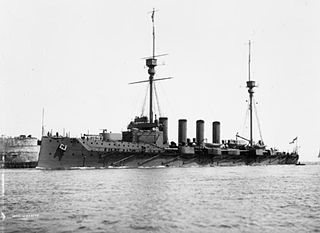
The Warrior class consisted of four armoured cruisers built for the Royal Navy in the first decade of the 20th century. After commissioning, all four sister ships were assigned to the Channel and Home Fleets until 1913 when Warrior was transferred to the Mediterranean Fleet. After the start of World War I in August 1914, Warrior participated in the pursuit of the German battlecruiser SMS Goeben and light cruiser SMS Breslau and her three sisters were assigned to the 2nd Cruiser Squadron of the Grand Fleet. Warrior joined the 1st Cruiser Squadron of the Grand Fleet in late 1914. Neither squadron participated in any of the naval battles in the North Sea in 1915. Natal was destroyed by a magazine explosion in late 1915 and only two of the ships participated in the Battle of Jutland in 1916. Cochrane was not engaged during the battle, but Warrior was heavily damaged and sank the following morning.
